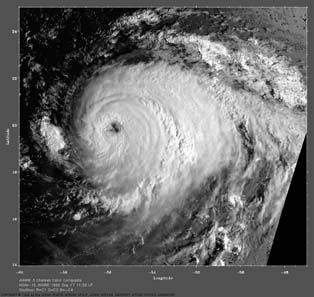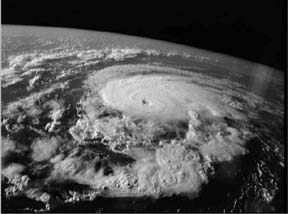
|
Archives:
Spring 2002 Table
of Contents Interested
in figuring out just how dangerous a hurricane might be? All you
need is a sense of adventure, a bit of expertise, and a P3 Orion
plane to pilot directly into the eye of the storm. Well, it's not
for everybody, but this dramatic method is in fact currently the
best way to measure the maximum wind speed of a hurricane, and thus
its potential risk to humans. It's also an expensive maneuver that
developing countries—often the hardest hit by hurricanes and
tropical cyclones—can ill afford.
Satellite imaging
technology is a reliable means of detecting and locating hurricanes.
However, even with satellite images, says Makris, assessments of
a hurricane's destructive power are off by at least an order of
magnitude, with scientists crudely estimating wind speeds. Those
estimates lead to critical decisions about evacuating coastal communities.
An unnecessary evacuation can mean millions of dollars in lost revenue;
and the lack of evacuation when a deadly storm strikes means the
loss of lives, in addition to the destruction of property.
The researchers
also plan to make measurements of their own by deploying an autonomous
underwater vehicle (AUV) during a hurricane in, say, waters off
the west coast of Florida, or in the Yucatan. The AUV would be sent
to the ocean floor—out of the hurricane's way—to make
one single-point measurement at various frequencies with the storm
arriving overhead. "No one has ever measured the ambient noise
level versus wind speed beyond about 30 knots in the ocean,"
notes Makris. "It just gets too rough and people stop taking
data or the equipment breaks." He also explains that the intensity
of underwater noise increases with the cube of the wind speed, at
speeds below 30 miles. This suggests that a similar relationship
would exist in hurricane conditions. By separating the hurricane
noise from the general bubbly noise of the ocean, and by discriminating
the direction of the hurricane, Makris hopes to discern the storm’s
power. Before heading too far afield, the researchers look forward to testing an ambient noise acquisition system in local waters. And those tests suggest other benefits to the technology. "Getting all these ambient noise measures as a function of location in the Charles River and in Boston Harbor will be very valuable," says Makris. The tests, for instance, could help establish definite correlations between marine mammal populations and noise pollution in coastal waters—a topic that has been its own maelstrom in recent years.
|

